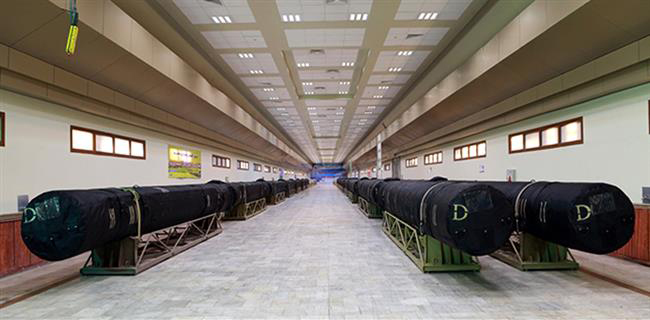- On March 8, 2015, Iran unveiled the Soumar long-range ground-to-ground cruise missile, which has a range of 2,500 kilometers. In the coming year Iran intends to upgrade its long-range missile array.
- Iran adamantly opposes the inclusion in the nuclear talks of its missile programs or any other issue, such as its involvement in terror, subversive activity in moderate Arab countries, and blatant human rights violations.
- Within range of the new cruise missile are American ships operating in the Persian Gulf, the Gulf States, Israel, moderate Arab states, parts of Russia, and countries in Central Europe.
- Exhibiting the missiles now was meant to coincide with sensitive nuclear talks. Tehran is signaling to the West that it has no intention of giving up its long-range missile program.
- Removing the sanctions from Iran — if an agreement is signed — will further accelerate the Iranian missile program, one of the flagships of Iran’s asymmetrical struggle with the West.
- Iran’s former Intelligence Minister: “Iran today has become an empire as it was throughout history and its capital now is Baghdad.”
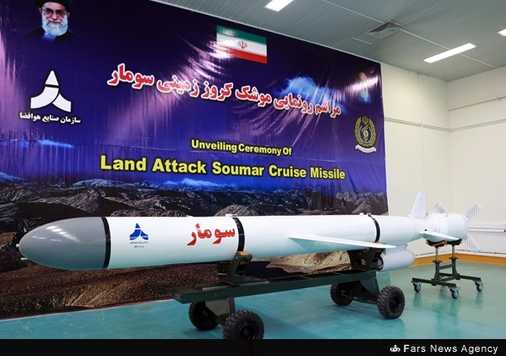
On March 8, 2015, Iranian Defense Minister Hussein Dehqan unveiled the Soumar long-range ground-to-ground cruise missile, which has a range of 2,500 kilometers and was developed by the Iranian Defense Ministry’s Aerospace Industries Organization. Dehqan said that the missile, which is equipped with up-to-date technologies such as pinpoint accuracy and advanced propulsion and navigation systems, is meant to boost Iran’s deterrent capability and power projection.
On the same occasion, Dehqan said that additional long-range Qadr and Qiyam missile systems had been transferred to missile units of the Iranian Revolutionary Guard Corps (IRGC), and that in the coming year Iran intends to upgrade its long-range missile array.
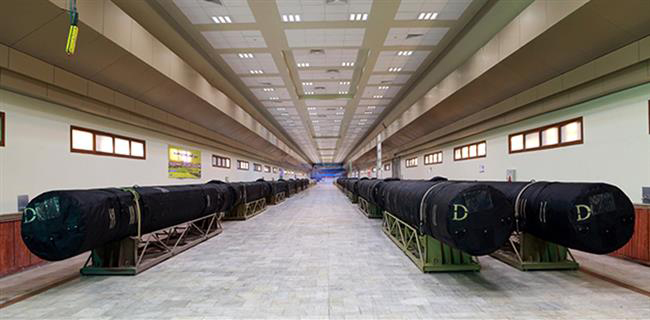
During the ceremony, the commander of the IRGC’s Aerospace and Missiles Force, Brigadier General Amir Ali Hajizadeh, lauded the ongoing development of Iran’s technological capabilities in the missile field despite “harsh sanctions.” He stated unequivocally that Iran would never agree to discuss its defense programs, especially in the cruise-missile field, as part of the nuclear talks.2 He added, “This is a message that the bullying powers, which raise illogical demands during the negotiations, must understand.”3
Significantly, Iran adamantly opposes the inclusion in the nuclear talks of its missile programs or any other issue, such as its involvement in terror, subversive activity in moderate Arab countries, and blatant human rights violations.
See also: Iran’s Show of Force Aimed at Pressuring the Nuclear Talks http://jcpa.org/irans-show-of-force-nuclear-talks/
The new cruise missile is a replica of the Soviet Kh-55 cruise missile, which disappeared in Ukraine over a decade ago and apparently found its way to Iran, which specializes in producing weapons systems through reverse engineering. Iran, when acquiring weapons systems, also insists on opening production lines within Iran. This is one of the lessons from the Iran-Iraq War, during which Iran found itself in distress when many countries refused to sell arms to it.
The cruise missile unveiled, as well as similar long-range missiles in Iran’s possession, expand the threat radius of the missiles held by the IRGC. They threaten the American ships operating in the Persian Gulf. Only last week the IRGC simulated the destruction of the USS Nimitz aircraft carrier using swarms of speedboats and missile fire. The Gulf States, Israel, and the moderate Arab states are also under the threat of Iran’s medium- and long-range missiles, and with the unveiling of the Soumar the threat radius has now expanded to a number of countries in Central Europe and to Russia.
Exhibiting the Missiles Meant to Coincide with Nuclear Talks
The sensitive timing of the unveiling of the cruise missile, just after Prime Minister Netanyahu’s speech to Congress and with the nuclear talks at a sensitive stage, is of great importance. Recently, as part of its negotiating strategy, Iran has been projecting power and self-confidence toward the West and its Arab neighbors. Having simulated an attack on a U.S. aircraft carrier, it continues to view the United States as its main likely threat.
Khorasan, a conservative Iranian newspaper, wrote in this regard, “Iran’s winning card in the nuclear negotiations is its tight control over the two strategic straits of Hormuz and Bab el-Mandeb…. (T)he era when American navy ships sailed the Persian Gulf to threaten Tehran … are over.” Referring to the destruction of the USS Nimitz model, Khorasan maintained that today military deterrence is a key factor in Iran’s national security doctrine and can help the nuclear negotiating team.4
Recently Iran also held the second major international competition for “Down with America” calligraphy.5
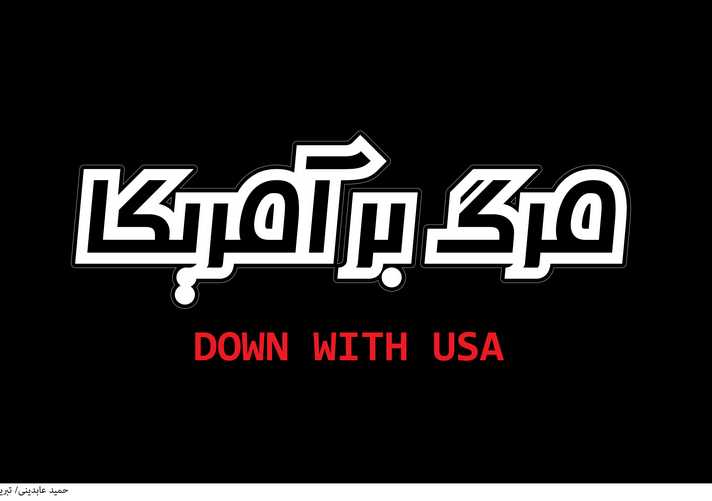
Ali Younesi, a senior advisor to Iranian President Rouhani and former Intelligence Minister during Khatemi’s tenure, has provided a stunning example of Iran’s hegemonic self-perception, growing confidence and power projection: “Iran today has become an empire as it was throughout history and its capital now is Baghdad, which is the center of our civilization and our culture and identity today as it was in the past…We will defend all the peoples of the region, because we consider them as part of Iran. We will fight Islamic extremism, Takfiris (apostates), atheists, neo-Ottomans, Wahhabists, the West and Zionism.” Referring to current IRGC operations in Iraq, he added that “Iran and Iraq are geographically indivisible and the culture cannot be dismantled, so you either have to fight together or unite.”6
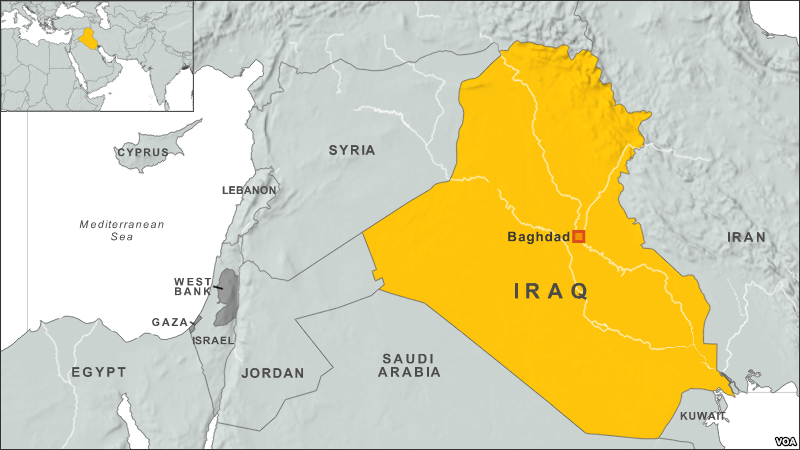
Former Iranian Intelligence Minister: “Iran today has become an empire as it was throughout history and its capital now is Baghdad.”
http://www.voanews.com/content/militants-seize-iraqi-town/1956460.html
Precisely at this sensitive juncture, Tehran is signaling to the West that it has no intention of giving up its long-range missile program (the missiles are capable of carrying nuclear warheads) or discussing it in any form during the nuclear talks. Iran also signals that it intends to keep developing missiles as part of building up its deterrence. Among other things, Iran can install these missiles on battleships and submarines and increase their range. About a year ago Iran announced its intention to organize a (two ship) flotilla that would demonstrate a presence along the U.S. coastline; eventually Iran canceled the plan when the flotilla was already on its way.7 Significantly, Iran also keeps refusing to let the International Atomic Energy Agency explore aspects of the “weaponization” linkage between the nuclear program and the missile program.
Iran is using its long-range missile program to provide a protective umbrella to its Middle Eastern allies, from Iraq to its west, to Syria and Lebanon, and to Yemen to the entrance to the Bab el-Mandeb Strait. This umbrella also facilitates the ongoing supply of rockets to the terrorist organizations that surround Israel from the north (Hizbullah, now in the Syrian Golan Heights as well as on the Lebanese front) and south (Islamic Jihad and Hamas in Gaza), which Iran regards as its first line of defense. Iran recently added its Houthi proxies in Yemen on the Saudi border. The long-range missile array, which Iran continues to develop despite the sanctions, forms part of its concept of defense and deterrence.
Removing the sanctions from Iran — if an agreement is signed — will further accelerate the Iranian missile program, one of the flagships of Iran’s symmetrical struggle with the West. Meanwhile it keeps developing its asymmetrical capabilities so that it can also provide them to its regional allies – Hizbullah and the Palestinian organizations – and test them in exercises directed at the American Fifth Fleet. Such exercises simulate the destruction of aircraft carriers and battleships and the blocking of the Strait of Hormuz and the Bab el-Mandeb Strait, which gives access to the Red Sea, as Iran strengthens its presence and its influence in Yemen.
* * *
Notes
1 http://www.presstv.ir/Detail/2015/03/08/400826/Iran-unveils-longrange-cruise-missile
2 http://english.farsnews.com/newstext.aspx?nn=13931217000730
3 http://www.farsnews.com/newstext.php?nn=13930528001038
4 http://www.khorasannews.com/News.aspx?type=1&year=1393&month=12&day=18&id=7148904
5 http://dw-usa.com/en/Last_Submited_File
6 http://www.isna.ir/fa/news/93121709862/%DB%8C%D9%88%D9%86%D8%B3%DB%8C-%D9%86%D8%AA%D8%A7%D9%86%DB%8C%D8%A7%D9%87%D9%88-%D8%AF%D8%B1-%D8%A7%D8%B8%D9%87%D8%A7%D8%B1%D8%A7%D8%AA%D8%B4-%D8%A8%D9%87-%D8%B9%D8%B8%D9%85%D8%AA-%D9%86%D9%81%D9%88%D8%B0-%D8%A7%DB%8C%D8%B1%D8%A7%D9%86 and http://www.alarabiya.net/ar/iran/2015/03/08/%D9%85%D8%B3%D8%AA%D8%B4%D8%A7%D8%B1-%D8%B1%D9%88%D8%AD%D8%A7%D9%86%D9%8A-%D8%A7%D9%8A%D8%B1%D8%A7%D9%86-%D8%A3%D8%B5%D8%A8%D8%AD%D8%AA-%D8%A7%D9%85%D8%A8%D8%B1%D8%A7%D8%B7%D9%88%D8%B1%D9%8A%D8%A9-%D8%B9%D8%A7%D8%B5%D9%85%D8%AA%D9%87%D8%A7-%D8%A8%D8%BA%D8%AF%D8%A7%D8%AF.html
7 http://www.payvand.com/news/14/apr/1087.html
– See more at: http://jcpa.org/article/irans-cruise-missile-2500km-range/#sthash.ZON3c9tw.dpuf





